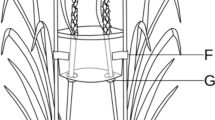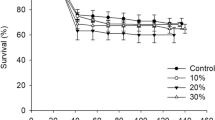Abstract
The lethal humidity (LH50) responses at 20°C of eggs of two strains of Neoseiulus fallacis (Garman) were 71.6 and 69.7%; of three strains of Amblyseius andersoni (Chant) were 62.9, 62.0 and 62.4% and of one strain each of Typhlodromus pyri Scheuten and Metaseiulus occidentalis Nesbitt were 55.0 and 28.4%, respectively. Eggs of three genetically distinct strains of A. andersoni from Oregon, the Netherlands and Italy did not respond differently from one another nor did eggs of freely hybridizing N. fallacis from Michigan and Oregon. Mortality of larvae through development to early protonymphs at 50% RH, 20°C. was 91.9, 82.3, 46.2 and 31.0% for fed mites and 98.1, 83.2, 67.0 and 89.7% for unfed mites of Oregon strains of N. fallacis, A. andersoni, T. pyri and M. occidentalis, repectively. Fed larvae-protonymphs of M. occidentalis and T. pyri were more tolerant of low humidity than fed larvae-protonymphs of N. fallacis and A. andersoni. Mortality was less for fed than unfed larvae-protonymphs of M. occidentalis and T. pyri, but there were no differences for A. andersoni and N. fallacis. Levels of feeding by predator larvae on T. urticae and cannibalism by phytoseiid protonymphs contributed to species differences. Responses to humidity are discussed in relation to geographic and host plant distributions and biological control by single or mixed species populations of phytoseiids.
Similar content being viewed by others
References
Anderson, N. H., Morgan, C. V. G. and Chant, D. A. 1958. Notes on occurrence of Typhlodromus and Phytoseius spp. in southern British Columbia (Acarina: Phytoseiidae). Can. Entomol. 90: 275–279.
Croft, B. A. 1990. Arthropod Biological Control Agents & Pesticides. Wiley Intersci. J. Wiley, N.Y. 723 pp.
Croft, B.A. and MacRae, I.V. 1992a. Biological control of apple mites by mixed populations of Metaseiulus occidentalis and Typhlodromus pyri (Acari: Phytoseiidae). Environ. Entomol. 21: 202–209.
Croft, B.A. and MacRae, I.V. 1992b. Persistence of Typhlodromus pyri and Metaseiulus occidentalis (Acari: Phytoseiidae) on apple after inoculative release and competition with Zetzellia mali (Acari: Stigmaeidae). Environ. Entomol. 21: 1168–1177.
Croft, B.A., Riedl, H.W. Shearer, P. and Fields, G. J. 1990. Distribution of Metaseiulus occidentalis (Nesbitt) and Typhlodromus pyri Scheuten in apple orchards of the Hood River Valley, Oregon. Can. Entomol. 122: 5–14
De Moraes, G. J., McMurtry, J. A. and Denmark, H.A. 1986. A catalog of the mite family Phytoseiidae: references to taxonomy, synonomy, distribution, and habitat. EMBRAPA-DDT 353 pp.
Downing, R.S. and Moilliet, T.K. 1971. Occurrence of phytoseiid mites (Acarina: Phytoseiidae) in apple orchards in south central British Columbia. Entomol. Soc. Brit. Columbia. 68: 33–36.
Dunley, J.E., Messing, R.H. & Croft, B.A. 1991. Levels and genetics of insecticide resistance in Italian and Oregon biotypes of Amblyseius andersoni Chant. J. Econ. Entomol. 84: 750–755.
Hadam, J. J., AliNiazee, M.T. and Croft, B.A. 1986. Phytoseiid mites (Parasitiformes:Phytoseiidae) of major crops in Willamette Valley, Oregon, and pesticide resistance in Typhlodromus pyri Scheuten. Environ. Entomol. 15: 1255–1263.
Mangini, A.C.Jr. and Hain, F. P. 1991. Vapor pressure deficit differentially affects laboratory populations of Metaseiulus occidentalis and Neoseiulus fallacis (Acarina: Phytoseiidae) reared together. Environ. Entomol. 20: 823–831.
McMurtry, J. A., Mahr, D. L. and Johnsonm, H. G. 1976. Geographic races in the predaceous mite, Amblyseius potentillae (Acari:Phytoseiidae). Intntl. J. Acar. 2: 23–28.
Messing, R.H. and Croft, B.A.. 1991. Biosystematics of Amblyseius andersoni and A. potentillae (Acarina: Phytoseiidae): Implications for biological control. Exp. Appl. Acarol. 10: 267–278.
Petersen, R. G. 1985. Design and Analysis of Experiments. Marcel Dekker Inc. N.Y. 429 p.
Raworth, D.A. 1990. Predators associated with the twospotted spider mite, Tetranychus urticae, on strawberry at Abbotsford, B.C., and development of non-chemical mite control. J. Entomol. Soc. Brit. Columbia. 87, 9 p.
Russell, R.M., Robertson, J.L. and Savin, N.E. 1977. POLO: a new computer program for computer analysis. Bull. Entomol. Soc. Amer. 23: 209–213.
Schuster, R.O. and Pritchard, A.E.. 1963. Phytoseiid mites of California. Hilgardia 34: 191–285.
Sabelis, M. W. 1985. Development. Chpt. 2.1.2.2. Vol 1B. p 43–53. In: Spider Mites: Their Biology. Natural Enemies and Contol. Ed. W. Helle and M.W. Sabelis. Elsevier. Amsterdam. 458 pp.
Strong, W.B. and Croft, B.A. 1993. Predaceous phytoseiid mites associated with spider mites on hops in the Willamette Valley, Oregon. J. Ent. Soc. Brit. Col. (in press).
van Dinh, N., Sabelis, M. W. and Janssen, A. 1988. The influence of humidity and water availability on the survival of Amblyseius idaeus and Amblyseius anonymous (Acarina: Phytoseiidae). Exper. Appl. Acarol. 4: 27–40.
Weires, R.W. McNicholas, B. J. and Smith, G. L. Integrated mite control in Hudson and Champlain Valley apple orchards. Search Agric. 9, 11 pp.
Zhang, N.X. and Kong, J.A. 1985. Responses of Amblyseius fallacis Garman to various relative humidity regimes. China J. Bio.-Control. 3: 6–9.
Author information
Authors and Affiliations
Rights and permissions
About this article
Cite this article
Croft, B.A., Messing, R.H., Dunley, J.E. et al. Effects of humidity on eggs and immatures of Neoseiulus fallacis, Amblysieus andersoni, Metaseiulus occidentalis and Typhlodromus pyri (Phytoseiidae): implications for biological control on apple, caneberry, strawberry and hop. Exp Appl Acarol 17, 451–459 (1993). https://doi.org/10.1007/BF00120503
Accepted:
Issue Date:
DOI: https://doi.org/10.1007/BF00120503




